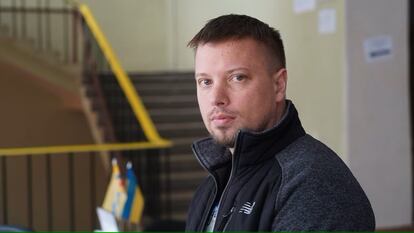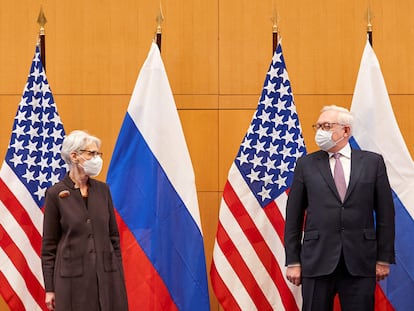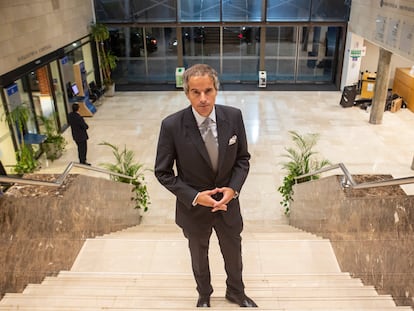Life under the shadow of Russian-occupied Zaporizhzhia: ‘This could be a second Chernobyl’
Ahead of the Ukrainian counteroffensive, concerns are growing over the safety of the nuclear power plant in Energodar, which was captured by Moscow at the beginning of the invasion. ‘If this explodes, only a shadow of us will remain’
Ostriv beach, mid-May 2023. On the shore are several Czech-made hedgehogs installed by the Ukrainian Army. These are anti-tank defenses made of metal bars intended to prevent Russian troops from landing. Next to them stands the dam wall, which is mined for the same purpose. On the other side are children’s swings, exercise bars and wooden benches painted blue and white, as well as an abandoned, flooded trench. Opposite, on the far bank of the Dnipro River, the six nuclear reactors of the Zaporizhzhia nuclear power station, Europe’s largest atomic power generator, tower menacingly. The plant has been under Russian control since March 4, 2022, when it was captured a few days after Moscow launched its invasion of Ukraine. Olga Muja, a local resident, casts her eye over the water toward them: “If this explodes, there will only be a shadow of us left.”
A sign on the beach announces that bathing is prohibited, but last summer the instruction was not paid much attention. Local residents swam and and basked in the sun, trying to maintain normal lives. But it is hard to forget the war in this village. Distant explosions are heard every now and then. Ostriv lies between the Russian positions and Nikopol and Marhanets in the Dnipropetrovsk region, two cities that have been constantly targeted by the Kremlin’s artillery. The village is located on the attack path toward both municipalities.
“Most people have left here,” says Olga, 66. “We hear gunfire every day, Grad rockets, artillery, and we are very afraid. I don’t understand what this war is about or why they want to kill us.” She says that she has no intention of leaving, that this is her home and that she wants to continue working her garden and taking care of her chickens and her orchard of 100 fruit trees. One of her six sons is fighting on the Bakhmut front. He calls her regularly: “Hi, I’m fine, I’m alive.”
Two of Olga’s neighbors, Raisa Sitnichenko, 76, and Valentina Riabchenko, 73, explain that they receive humanitarian aid once a month, including water and food, but that life here is extremely difficult. Valentina sometimes goes to stay at her son’s house in Marhanets when things get really bad. “These houses are old and we have no shelters,” Raisa adds.
The nearest large town to Ostriv is Nikopol, also opposite the nuclear power plant, which is located in Energodar. The road between the two municipalities is teeming with partridges and, above all, pheasants. As hunting has been banned for over a year because of the war, there are many more birds and they stroll quietly along the roads with their long tails and colorful feathers.
In Nikopol, explosions can be heard again, and the six reactors of the nuclear power plant loom even larger on the far side of the Dnipro. The area is a red zone, as designated by the General Staff of the Ukrainian Armed Forces. A red zone implies that journalists cannot enter without express authorization and must be accompanied at all times by a military officer.
Under martial law, which was imposed in February 2022 when the invasion began, the Ukrainian Army has sweeping powers, even over fundamental rights such as the right to information or freedom of movement. Authorization to enter a red zone may be granted within a few days, or it may not come at all, depending on priorities at that moment. The Bakhmut front is a red zone, based on the logic that the lives of journalists are in extreme danger there and troop movements are classified. Nikopol is a red zone because of its proximity to Energodar and the nuclear plant. From undetermined locations along this stretch of the Dnipro, Ukrainian special forces have probed Russian defenses at the station with swift, small-scale amphibious landings.
Raisa Stnelcova, 80, and Nadia Suslova, 72, walk past a four-story building in Nikopol that was shelled at 2 a.m. on August 11. They live next door. “It really frightened us,” Raisa recalls. “Now, we are attacked every day, several times a day.” They, too, are worried about the proximity of the nuclear power plant. “This could be a second Chernobyl,” says Raisa, referring to the northern Ukrainian town, which was the site of the biggest nuclear disaster in history in 1986, when it was part of the USSR.
The mayor of Energodar before the Russian occupation is confident that the Ukrainian Army’s counteroffensive will be successful and the plant will be recaptured. His name is Dmitro Orlov, he is 37, and he now lives in Zaporizhzhia and holds his office in exile. He speaks to EL PAÍS from a center set up to provide humanitarian aid to the inhabitants of Energodar who fled when the Russians arrived. “There used to be about 53,000 people living there, and now there are about 15,000,″ he says. “Some went overseas, but most of them are in Ukraine waiting for the liberation of the city to return to their homes.”
There used to be about 53,000 people [in Energodar], and now there are about 15,000,″Dmitro Orlov, mayor of Energodar
The nuclear power plant produces almost no electricity. All six reactors are operating at minimum mode, known as cold shutdown. The neighboring thermoelectric station is also dormant. Before the war, Energodar generated half of Ukraine’s nuclear-powered electricity. “We hope that the counteroffensive will be successful so that the power plant can resume its activities, generate much-needed electricity and the city can return to normal life,” says Orlov.
A team of experts from the International Atomic Energy Agency (IAEA) has been monitoring the plant’s safety since September last year. The agency’s director general, Rafael Grossi, warned this week that the plant had lost all external electricity for the seventh time during the conflict, forcing it to rely on emergency diesel generators. “[The] nuclear safety situation at the plant [is] extremely vulnerable. We must agree to protect [the] plant now; this situation cannot continue” he wrote on Twitter.
Oleksii Blinechuk worked at the plant until last summer, when he left for Zaporizhzhia with his family. He says the Russians have hired inexperienced managers to run the nuclear station. “These are people who have nothing to do with the energy sector and should not be there,” he states. He still keeps in touch with some of his colleagues who remain at the plant.

The Zaporizhzhia front may be the most decisive of the war, as U.S. and U.K. military intelligence have publicly stressed. The Ukrainian military in the area and defense analysts agree. “Everyone is watching Bakhmut, but what happens here is more important,” Stepan, an officer in the Artey infantry battalion, told this newspaper last February.
A breakthrough on the Zaporizhzhia front would allow Ukrainian troops to advance towards the coast of the Sea of Azov without having to stage a landing on the Dnipro River, which is an extremely complex undertaking, according to military experts. If Kyiv liberates the province, it would also regain control of Energodar and the nuclear plant. The next stage, which would represent a significant victory, would be to reach the city of Melitopol, on the Sea of Azov. From there, Ukrainian forces could cut off supply lines to Russian troops along the coast, toward Kherson, the Black Sea, and Crimea.
If the Ukrainian counteroffensive is staged in Zaporizhzhia, every urban center could be turned into a defensive fortress by Russian troops and the fighting could devastate entire towns, as was the case with the counteroffensives last year in the provinces of Kherson and Kharkiv. But if the Russians maintain their positions around the nuclear power plant, the risk will not be that a village will be razed to the ground, but that millions of people could be affected, only their shadows remaining, as feared by Olga. The question is whether the Kremlin would order its troops to withdraw if they are surrounded, or whether Moscow will continue to play the atomic blackmail card.
Credits
Follow all the international news on Facebook and Twitter, or on our weekly newsletter.

